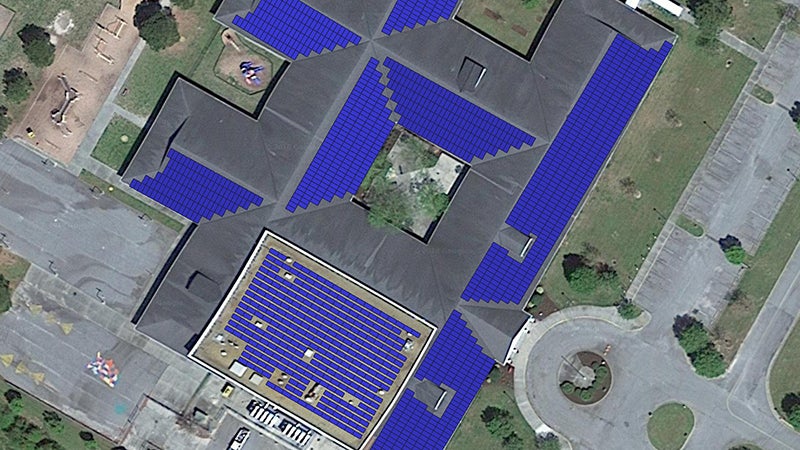Solar panels on schools?
Published 4:47 pm Monday, September 9, 2019

- This rendering by HelioScope shows how solar panels could be affixed to the roof of Windsor Elementary. IWCS estimates that roughly 78 percent of the school’s energy needs could be generated via the solar panels.
|
Getting your Trinity Audio player ready...
|
WINDSOR
Isle of Wight County Schools is seeking proposals from solar energy companies for the installation of solar panels its schools.
According to Superintendent Dr. Jim Thornton, the school division hopes to enter into a power purchase agreement, which would specify that the solar company is to install the panels at its own expense. This would ensure there is no upfront cost to IWCS. In return, IWCS would agree to purchase the power generated from the panels and use it to power each of the schools on which the panels are located.
Thornton explained that the school division would benefit financially from this arrangement by paying a lower rate for electricity to the solar company than what the division would have paid to Dominion Energy. According to estimates division staff presented to the IWCS School Board on Aug. 8, roughly 78 percent of Windsor Elementary School’s electricity needs can be generated through solar power. This is despite that school’s angled roof, which, according to division staff, can support fewer solar panels than schools with flat roofs.
At Windsor High School, however, which does have a mostly-flat roof, only about 43 percent of the school’s electrical needs can be generated through solar. This is due to where the sun hits during the school year and for how long each day.
The remainder of each school’s annual power needs, according to Thornton, would still come from Dominion and be paid for on the division’s standard utility bill. The projected savings division-wide are projected to be just over $104,000 annually, and roughly $3.9 million after 25 years.
At the Aug. 8 School Board meeting, division staff showed renderings by HelioScope, a solar design company, of how solar panels could be arranged on six of the division’s nine schools, these being Hardy Elementary, Westside Elementary, Smithfield Middle, Smithfield High, Windsor Elementary and Windsor High. However, according to Lynn Briggs, the division’s director of community and media relations, the RFP will not ask for solar panels on a specific number of schools. Which schools, if any, ultimately receive solar panels, she said, will depend on what each solar company that responds to the RFP recommends.
Division staff estimate that for Hardy, Westside and Smithfield High, solar panels could supply upwards of 70 percent of the power needs for each of those schools. Smithfield Middle, however, is estimated to draw only around 22 percent of its power needs from solar due to its A-frame roofs.
The advantage of this agreement to whichever solar company the School Board selects is that it will enable that company to be eligible for a federal tax credit. John Hollis — a development analyst for the solar company Ecoplexus Inc., which is planning to construct a solar farm just outside of the town of Windsor — explained that the federal business energy investment tax credit offers a 30-percent tax credit to companies that invest in a renewable energy system such as solar panels.
“Municipalities and school districts typically don’t pay taxes, so they can’t take advantage of the credit if they own the system,” Hollis said. “However, if the system is owned by a developer and the district signs a PPA, the developer can take advantage of the credit, and potentially pass those savings on within the PPA.”
“That’s what makes it profitable for [solar companies],” Thornton said. “They want to get the schools or municipalities online while those tax credits are still viable.”
He then explained that IWCS and whichever solar company the division chooses would need to have a PPA in place before January 2020 in order to remain eligible for the 30-percent tax credit.
According to the online Database of State Incentives for Renewable Energy, which is funded by the U.S. Department of Energy, this federal tax credit will drop to 26 percent in 2020, 22 percent in 2021 and 10 percent for future years.
“The way the [tax credit] law has been amended, as long as the project has started, the company paying for the solar can take the tax credit at that year’s rate,” said Chad Wilkins, president of Convert Solar. “Power purchase agreements are governed by each state and the utility.”
Convert, according to Briggs, is one of the companies that has approached IWCS about solar projects.
According to Wilkins, Dominion Energy and Virginia’s State Corporations Commission are allowing 50 megawatts of power purchase agreements in Dominion territory.
“This is what will fill up soon, making it much harder for schools to have solar [in the future],” Wilkins said. “Once tax credits are earned, they are good for a long time. It is like real money you have given the IRS (Internal Revenue Service).”




